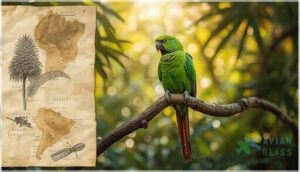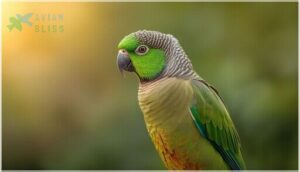This site is supported by our readers. We may earn a commission, at no cost to you, if you purchase through links.
Green cheek conures pack the personality of a macaw into a body that fits in your hand. These palm-sized parrots from South America have become one of the most popular companion birds in the world, and it’s easy to see why. They bond deeply with their owners, learn tricks faster than most dogs, and won’t blow out your eardrums like their larger cousins.
But don’t let their manageable size fool you. A green cheek conure needs daily interaction, a carefully balanced diet, and veterinary care that can run into thousands of dollars over their 25-year lifespan. Before you bring one home, you need to understand what you’re signing up for—from their morning squawks to their maroon belly feathers.
Table Of Contents
- Key Takeaways
- Green Cheek Conure Species Overview
- Origin and Natural Habitat
- Personality and Behavior Traits
- Diet and Nutrition Needs
- Housing and Exercise Requirements
- Health, Lifespan, and Care
- Frequently Asked Questions (FAQs)
- Where do green cheeked conures live?
- How do Green Cheek Conures hold their food?
- What are green cheeked conures?
- When do green cheeked conures come out?
- Are green cheek conures good pets?
- How much should a green cheek conure cost?
- Do green cheek conures talk a lot?
- Do green cheek conures like to be held?
- How often do green cheeks need to socialize with other birds?
- What age is best to adopt a green cheek?
- Conclusion
Key Takeaways
- Green cheek conures live 10–25 years and require daily interaction, specialized veterinary care, and a financial commitment of $570–$1,250 annually plus emergency costs that can exceed $1,000.
- These birds need minimum cage dimensions of 20 x 20 x 36 inches, 3–4 hours of supervised out-of-cage time daily, and a diet based 75–80% on quality pellets with strict seed limitation under 20%.
- Common health threats include PBFD (16% prevalence), aspergillosis from inhaled fungal spores, and nutritional deficiencies that require annual wellness exams and routine screening with an avian veterinarian.
- Unlike larger parrots, green cheeks produce conversational-level vocalizations (60–77 dBA) and rarely learn more than a few words, making them apartment-friendly but still demanding of social bonding across all household members.
Green Cheek Conure Species Overview
If you’re thinking about bringing a green cheek conure into your home, it helps to know what you’re actually getting. These little parrots pack a lot of personality into a compact frame, and they come with some specific traits that set them apart from other pet birds.
Let’s start with the basics of what makes a green cheek conure unique.
Scientific Name and Classification
The green cheek conure’s scientific name is Pyrrhura molinae. Massena and de Souancé first described this species in 1854 from Bolivia. You’ll find it classified in the family Psittacidae and genus Pyrrhura, which includes over 20 South American species. They’re known to thrive in dense forest habitats.
- Six subspecies exist across Bolivia, Brazil, Paraguay, and Argentina
- The IUCN lists it as Least Concern despite habitat loss
- Common names include green-cheeked parakeet and Argentine conure
Physical Appearance and Size
Adult size in these birds is compact, measuring 25–26 cm from head to tail. You’ll see a body weight of 60–80 g on average. Their wingspan stretches about 16.5 cm.
Body proportions include a long, tapered tail and short wings. Plumage coloration shows green cheeks, a gray-brown cap, and a scalloped breast. The abdomen features a maroon patch.
| Feature | Description |
|---|---|
| Length | 25–26 cm total |
| Weight | 60–80 g average |
| Tail | Long, maroon-red |
Sexual dimorphism isn’t visible externally—males and females look identical. Feather count reaches 5,000–7,000 per bird. The molting process sheds old feathers while new pin feathers emerge. Juveniles display duller colors initially.
Green-cheeked conure characteristics include blue flight feathers and a white eye ring. Their green-cheeked conure appearance stays consistent across individuals, though color variations exist in captive-bred lines. These birds have an average lifespan of 10–15 years.
Common Color Mutations
Beyond the wild-type plumage, you’ll find multiple color variations in captive breeding. Cinnamon, Yellow-sided, Turquoise, and American Dilute are the four foundational mutations. Combination morphs like Pineapple (Cinnamon plus Yellow-sided) and Suncheek create even more eye-catching options.
Mutation inheritance follows sex-linked or autosomal recessive patterns. Pricing factors include rarity trends—common mutations cost $200–$350, while Turquoise or American Dilute birds reach $400–$700. Visual identification lets you spot these Greencheeked conure colors easily.
Lifespan and Longevity
With proper care, your conure’s lifespan stretches 10–25 years, though some reach 30 under ideal conditions. Wild longevity faces pressures from habitat loss and predation. Three factors shape life expectancy:
- Nutrition quality—seed-heavy diets trigger vitamin deficiencies that accumulate over time
- Routine veterinary visits—early disease detection extends aging trajectories
- Environmental enrichment—exercise and mental stimulation support healthier longevity benchmarks
Disease burdens like PDD and aspergillosis remain key influencing factors.
Origin and Natural Habitat
Your green cheek conure didn’t just appear in pet stores one day. These little birds come from a specific part of the world with unique environmental conditions that shaped their behavior and needs.
Let’s look at where they’re from and what their natural home looks like.
Native Range and Distribution
You’ll find wild green-cheeked conures across central South America, with native populations in Argentina, Bolivia, Brazil, and Paraguay. Six subspecies show subtle variation throughout this range.
Habitat loss has shrunk the population, yet the species remains common where forest mosaics persist.
Some birds move to lower elevations during cooler months, demonstrating altitudinal migration.
No major introduced populations exist beyond the native region.
Wild Habitat Preferences
Green-cheeked conures thrive in South America’s forests, from lowland woodlands to cloud forests at elevations up to 2,900 meters. You’ll spot them in the Amazon basin’s forest structure, where they prefer tree canopy and subcanopy layers.
These birds nest in tree cavities about 18 inches deep, lining them with twigs and leaves. Their natural habitat includes deciduous forests, gallery woodlands, and forest edges where food sources like figs and diverse flowering trees grow year-round.
Conservation Status and Threats
Although green-cheeked conures hold Least Concern status on the IUCN Red List, you should know their populations face real pressures:
- Habitat loss from rapid forest clearance affects regional numbers, especially in eastern Bolivia
- CITES Appendix II regulations control international trade to prevent future extinction risk
- Population trends show decline despite the species remaining common across most of its range
- Wild capture for the pet trade continues, though not in large numbers
- Monitoring needs focus on areas with agricultural expansion and deforestation fronts
Personality and Behavior Traits
Green cheek conures pack a lot of personality into a small body. They’re curious and playful birds that bond closely with their people.
Here’s what you can expect from their temperament and behavior.
Temperament and Social Nature
Think of your green-cheeked conure as a tiny comedian with a big heart. These birds bond strongly with your entire household, not just one person. They’re outgoing, playful, and love hanging upside down just for fun.
You’ll need to provide daily interaction and supervised out-of-cage time—their affectionate temperament thrives on social contact, and without it, behavioral problems like feather-plucking can develop.
Vocalizations and Noise Level
Your green cheek conure vocalizations sit comfortably below the ear-splitting range of larger parrots. Call amplitude generally peaks around 60–77 dBA—roughly conversation-to-loud-conversation level—making these birds apartment-friendly.
Expect vocal peaks at dawn, when over half their daily chatter concentrates in the first few morning hours. Contextual factors like background noise can ramp up their calling, so noise management through routine and environment helps keep things peaceful.
Intelligence and Trainability
Parrots carry neuron-packed brains that rival primates in problem solving, and your green cheek conure is no exception. These birds coordinate, solve string-pulling puzzles, and adapt strategies on the fly.
Clicker training with positive reinforcement unlocks impressive skill generalization—start with target training to build confidence, then shape basic commands through short training sessions. Their social learning abilities mean consistent, well-timed rewards turn training into a surprisingly smooth ride.
Affection and Interaction With Humans
Training sharpens their mind, but these birds crave genuine connection. Your green-cheeked conure personality revolves around physical affection and attention-seeking—they’ll nuzzle your neck, solicit head scratches, and stay glued to your shoulder.
To nurture a well-adjusted family pet while avoiding over-bonding:
- Rotate handling among household members
- Offer two daily interaction sessions, not one marathon
- Balance hands-on contact with independent play nearby
- Keep stroking limited to head and neck
These shared activities and consistent social bonding deliver the best welfare outcomes.
Diet and Nutrition Needs
Your green cheek conure needs the right fuel to stay healthy and happy. A good diet keeps their feathers bright, their energy up, and their immune system strong.
Here’s what you need to know about feeding your bird.
Recommended Daily Diet
Generally, your green-cheeked conure diet should rest on a pellet-based foundation. Quality pellet food makes up 75-80% of daily intake, ensuring nutritional balance without deficiencies.
You’ll want to provide about 5-9 grams daily, roughly 1-2 tablespoons depending on your bird’s weight. Keep seed limitations strict—under 20% total—since seeds lack essential vitamins. Portion sizes matter for these small birds, so monitor their healthy diet closely.
Fresh Fruits and Vegetables
Beyond pellets, you’ll want to add fresh produce to your bird’s nutritionally balanced diet. Fresh fruits and vegetables should make up 10-20% of daily intake, offering vitamins and enrichment. Here’s what works well for your green-cheeked conure diet:
- Nutrient-dense vegetables: Carrots, sweet potato, pumpkin, and leafy greens like kale provide vitamin A and minerals.
- Safe fruits in moderation: Berries, melon, apple (seeds removed), and grapes add variety without excessive sugar.
- Vegetable variety matters: Rotate corn, peas, beans, and squash weekly for broader nutrient coverage.
- Feeding frequency: Offer fresh produce once daily, removing uneaten portions within 2-4 hours.
Wash everything thoroughly and skip seasoning entirely—your conure needs plain, fresh food to thrive.
Foods to Avoid
Some foods aren’t just unhealthy—they’re dangerous. Toxic fruits like avocado contain persin, which causes respiratory failure in birds within hours. Chocolate toxicity from theobromine affects the heart and liver. Xylitol dangers include sudden hypoglycemia and death within minutes. Allium risks from onions and garlic damage red blood cells.
Raw beans, fruit pits, alcohol, and high-salt snacks don’t belong in your greencheeked conure diet.
Foraging and Feeding Enrichment
Keeping your bird’s mind sharp means turning meals into mini-adventures. Wild parrots forage 4–8 hours daily—your green-cheeked conure personality thrives on the same challenge. Puzzle feeders and device rotation prevent boredom while extending foraging time to match natural behavior.
- Target 2–4 hours of daily enrichment types using combined search-and-extract tasks
- Rotate feeders weekly and place devices at different perch heights
- Contrafreeloading—working for food when free food exists—improves feather health
An enriched environment aids your green-cheeked conure diet and reduces stereotypic behaviors, following bird feeding guidelines that prioritize play and foraging.
Housing and Exercise Requirements
Your green cheek conure needs a cage that gives them room to move, play, and stretch their wings. Beyond the basics, you’ll want to think about perches, toys, and how much time they spend outside the cage each day.
Here’s what works best for keeping your bird healthy and happy.
Minimum Cage Size and Setup
Your green cheek conure needs a cage with minimum internal dimensions of 20 x 20 x 36 inches to allow flapping and climbing. Choose cage bar spacing between 0.5 and 0.75 inches to prevent head entrapment.
The cage interior layout should include staggered perches with clearance from walls for wing extension. Position food and water stations separately. Secure door latch safety prevents escapes.
Place the cage in well-ventilated areas away from kitchens to avoid toxic fumes.
Perches, Toys, and Environmental Enrichment
Your conure’s foot health depends on varied perch diameters between 3/4 and 1 1/4 inches. Uniform dowels cause pressure sores, so mix natural wood branches with rope perches across multiple heights.
Position full-spectrum lighting near perches to support vitamin D synthesis when natural sunlight isn’t available.
- Rotate bird toys every 1–2 weeks to maintain novelty and prevent boredom
- Include chewable, puzzle, and shredder toys for balanced stimulation
- Add foraging enrichment through puzzle feeders and scatter feeding to increase activity time
Out-of-Cage Exercise and Socialization
Flight exercise shapes your conure’s physical and mental health more than any other daily activity. Aim for 3–4 hours of supervised time outside the cage each day, mixing structured play sessions with calm social interaction alongside your household.
Flock bonding happens naturally when your bird participates in family routines. Mental stimulation through bird training games and short flight intervals reduces stress behaviors while strengthening your bond with proper Greencheek conure behavior patterns.
Health, Lifespan, and Care
Your green cheek conure can live 20 to 25 years with proper care, but that longevity depends on catching problems early and staying ahead of common health risks. These birds hide illness well, so you need to know what to watch for and when to act.
Here’s what you should understand about keeping your conure healthy, recognizing trouble signs, and what to expect when bringing one home.
Common Health Issues
Your feathered friend might seem invincible, but green cheek conures face several avian diseases you need to watch for:
- PBFD — A viral infection with roughly 16% prevalence across parrots that damages feathers and beaks
- Aspergillosis risks — Fungal respiratory infections from inhaled spores, especially common in captive birds
- Nutritional deficiencies — Vitamin A and calcium shortfalls that weaken immunity
- Feather plucking — Often stress-related or dietary
- PaBV infection — Causes digestive problems and weight loss
Preventative Veterinary Care
Your conure needs an annual wellness exam with an avian veterinarian to catch problems early. During checkups, expect blood work, weight monitoring, and fecal testing for parasites. Disease screening for PBFD and psittacosis provides baseline health data for future comparisons.
You’ll need nail trims every 4-6 weeks and regular worming treatments every three months.
New birds require 30-45 days quarantine with separate veterinary screening.
Signs of Illness
Between checkups, watch for warning signs at home. Feather changes like persistent fluffing or unkempt plumage signal trouble.
Activity levels drop when birds get sick—they’ll sleep more and hide instead of playing. Appetite changes, weight loss, and abnormal droppings (watery, discolored, or fewer than usual) all need attention.
Breathing problems like tail-bobbing or open-mouth breathing mean call your avian veterinarian right away. Physical abnormalities, from overgrown beaks to swollen eyes, shouldn’t wait.
Adoption Considerations and Costs
Before you bring home a green-cheeked conure, understand the real commitment. Pet adoption isn’t just about the bird—it’s about years of daily care and significant costs.
Adopting a green-cheeked conure means committing to decades of daily care and significant ongoing expenses, not just buying a bird
Initial and ongoing financial reality:
- Initial costs range from $150–$600 for the bird, plus $50–$500 for a proper cage and setup
- Ongoing expenses run $570–$1,250 yearly for food, toys, and routine care
- Veterinary risks include emergencies exceeding $500–$1,000 per event
- Time commitment spans 10–25 years with daily interaction required
Where to adopt or buy matters—reputable rescues often include cages and charge around $300.
Rehoming risks increase when owners underestimate green-cheeked conure costs of ownership over decades.
Frequently Asked Questions (FAQs)
Where do green cheeked conures live?
Green-cheeked conures range across an absolutely enormous swath of South America—Bolivia, Brazil’s Mato Grosso, Paraguay, and Argentina—inhabiting subtropical forests and woodlands up to 2,600 meters elevation where climate sustains their year-round foraging.
How do Green Cheek Conures hold their food?
You’ll notice your conure using zygodactyl feet—two toes forward, two back—to grasp food items with impressive precision.
This footedness bias lets them stabilize snacks while their beak coordination accomplishes the detailed work of shelling and nibbling.
What are green cheeked conures?
Think of a pocket-sized parrot with a big personality—that’s your green-cheeked conure. This small psittacine (Pyrrhura molinae) weighs just 60–80 grams but packs vibrant plumage and considerable social intelligence into its compact frame.
When do green cheeked conures come out?
Your conure will wake at sunrise and stay active for 12–14 hours during daylight. Daily activity peaks in early morning and late afternoon. They need 10–12 hours of darkness nightly for rest.
Are green cheek conures good pets?
Yes, they’re excellent pets for beginners and families. You’ll find them affectionate and playful, perfect for apartment living due to quieter vocalizations.
However, commitment to daily interaction and 15+ year care is essential.
How much should a green cheek conure cost?
Purchase price ranges from $150 to $600 for standard birds, with rare color mutations costing $400 to $ Setup costs add $70 to $300, while ongoing expenses average $300 to $1,800 yearly.
Do green cheek conures talk a lot?
Most parrots surprise you with chattiness, but green cheeks don’t fit that mold.
They can learn a few words with limited mimicry ability and gravelly speech, though their vocal volume stays low compared to louder conures.
Do green cheek conures like to be held?
Most hand-raised individuals are highly affectionate and seek close contact daily.
Individual variation exists—early socialization, consistent training, and recognizing stress signals determine whether your bird will enjoy being held or prefer perching nearby.
How often do green cheeks need to socialize with other birds?
Your green cheek doesn’t need daily conspecific access, but pair housing offers behavioral benefits like reduced stereotypy and increased stimulation.
Solitary birds need 2–4 hours of social enrichment and exercise daily with you to prevent personality and behavior problems.
What age is best to adopt a green cheek?
You’ll find handfed, weaned baby conures ready around 8–10 weeks post-weaning—perfect for bonding. Adult adoption at 4–5 years offers behavioral maturity and ethical appeal, with decades of companionship still ahead.
Conclusion
A green cheek conure fits in your palm but demands the same commitment as a toddler. You’ll spend decades meeting their social needs, veterinary bills, and daily routines.
Yet thousands of owners wouldn’t trade it for anything. These birds form bonds that outlast most friendships.
If you’re ready for the responsibility, you’re not just getting a pet. You’re gaining a feathered companion who’ll greet every morning like you’ve been gone for years.
- https://poparrots.com/2023/05/04/green-cheek-conures/
- https://arborviewah.com/wp-content/uploads/2021/07/Conures.pdf
- https://thevetdesk.com/pet-health-wellness/birds/green-cheek-conure-lifespan-how-long-do-they-live/
- https://www.absoluteexoticssa.co.za/specialized-care/care-for-conures/63-conure-life-span
- https://www.phoenixlanding.org/nutrition.html













